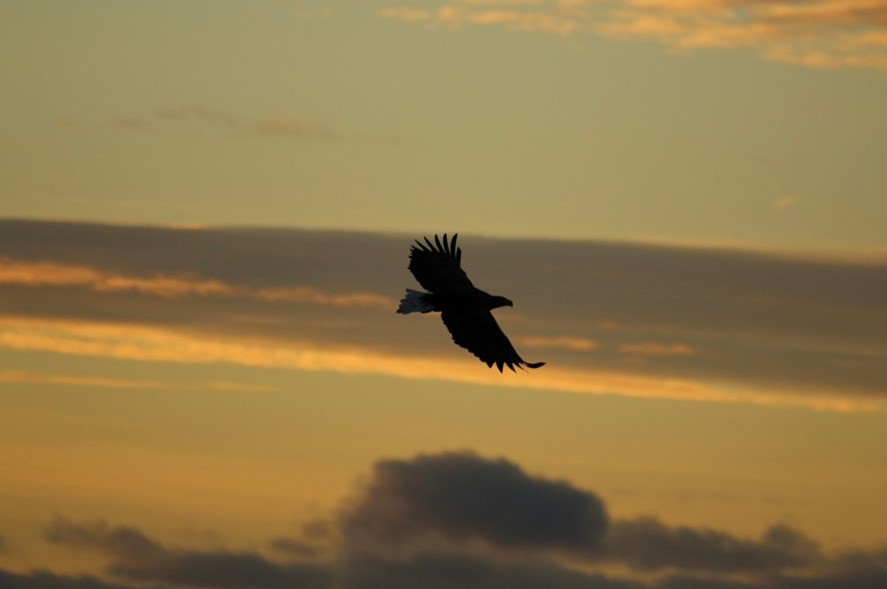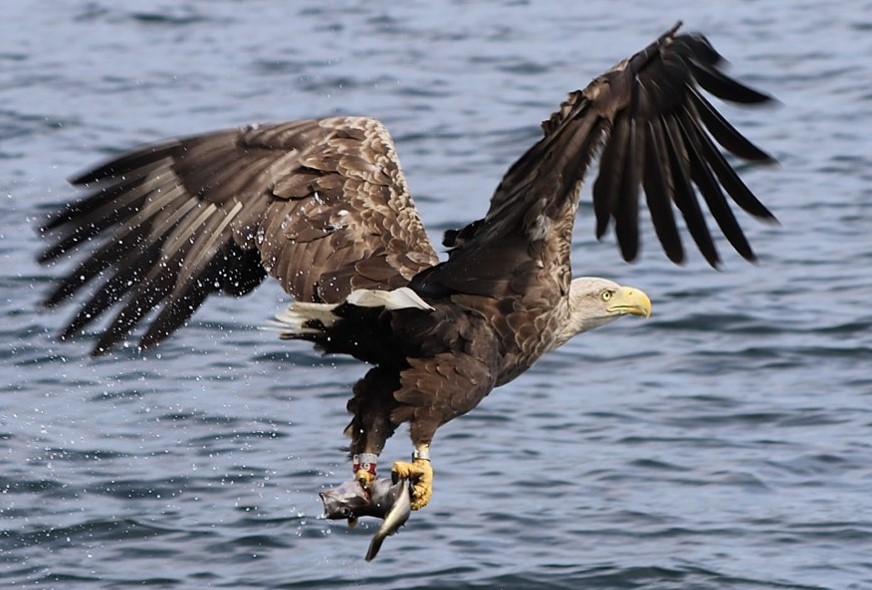Press release from RSPB Scotland (28 March 2022)
White-tailed eagles bring tourism boost to Mull
New study reveals significant benefits to the island’s economy
- Between £4.9 million and £8 million of tourist spend is attracted annually by the birds
- Up to 160 jobs are supported by this spend
- At least £2.1 million of local income is also supported
A new study “The Economic Impact of White-Tailed Eagles on the Isle of Mull” has revealed the scale of the economic benefits that white-tailed eagles bring to the island. Tourism inspired by these majestic birds of prey accounts for between £4.9 million and £8 million of spend every year here. This money supports between 98 and 160 full time jobs on the island, and between £2.1 million and £3.5 million of local income annually.
[Photo by Amanda Ferguson]
RSPB Scotland commissioned Progressive Partnership to undertake the study, which was then reviewed by an academic and an economist. During the summer of 2019, 398 face to face survey interviews were conducted at five sites across Mull with parties visiting the island, amounting to 1,248 people in total.
Information was recorded on holidaymakers and day trippers covering the number of people in the group, the amount of time they were staying, and the amount of money they were likely to spend a day. They were also asked about their motivation for their visit allowing for the importance of white-tailed eagles as an attraction to be recorded. Those who were local (12.4 percent) were not asked these questions.
This study is the third to be undertaken on Mull looking into the economic impact white-tailed eagles have here, following the first in 2005 and the second in 2010. It repeated the same surveys and process as the 2005 and 2010 independent studies allowing a comparison over 14 years of the increasing importance of white-tailed eagle tourism to Mull’s local economy.
Mull is home to 22 pairs of eagles, and in 2019 29 percent of tourists cited them as an important factor for their visit to the island, up from 23 percent in the 2010 study. Tourism spend inspired by these eagles has also increased since 2010 when it accounted for between £3 million and £5 million annually, which supported between 64 and 108 full time jobs, and between £1.4 million and £2.4 million of local income each year.
The importance of nature in driving Mull tourism was also highlighted with scenery and landscape, peace and tranquillity, and birds and wildlife also being given as some of the main reasons for visits in 2019.
White-tailed eagles used to be widespread across Scotland, but human persecution led to their extinction in 1918. A reintroduction programme began on the Isle of Rum in 1975 and in 1985 the first wild chick from the reintroduced population hatched on Mull.
[Photo by Amanda Ferguson]
Anne McCall, Director, RSPB Scotland said: “Mull once again holds an important breeding population of white-tailed eagles, which are an incredible tourism draw for the island. This study makes clear the link between restoring nature and the local income earning opportunities that arise from it. However, living with these birds can pose challenges for some and it’s important that positive management protects both the birds and the livelihoods they can occasionally affect.
“What the study can’t measure is those human benefits less tangible than economic ones such as physical and mental well-being, public education, and cultural resonance. The Scottish population of these birds also provides important indications of how our environment is faring in the nature and climate emergency. For many people the delight of seeing a white-tailed eagle is reason enough to take care of them but this study makes clear that the birds can pay their way too.”
Biodiversity Minister Lorna Slater said: “Scotland’s special wildlife brings many benefits – it attracts tourists to our shores and provides nature-based jobs that support our economy.
“That is why it is crucial that we must continue to support and protect Scotland’s bird of prey populations, such as the white-tailed eagle. Carefully managed re-introductions such as this one on Mull, are not only positive for the natural world but also positive for our communities.
“Scotland was one of the first countries to recognise the twin crises of nature loss and climate change, and this report shows the many rewards that working together to protect our natural assets can offer.” Partnerships have been key to the success of the white-tailed eagle reintroduction in Mull including those between nature conservation organisations, funders, land managers and the local community. The award-winning Mull Eagle Watch began in 2000 to provide places where people could have great views of the birds without disturbing them, and is a partnership between RSPB Scotland, the Mull & Iona Community Trust, Forestry and Land Scotland, NatureScot and Police Scotland. Thanks to social media and television programmes the white-tailed eagles have become well known, and along with the presence of golden eagles here have led to Mull being dubbed “Eagle Island”.
ENDS
The new report can be downloaded here:
RSPB Scotland has published a 7-minute video to accompany today’s publication. The video can be watched here:



England should follow Scotand’s example instead of killing them. Three this year I believe.😪
Scotland does a pretty good job of poisoning it’s sea eagles, Michael:
Great to see these birds becoming mainstream tourist fodder and accepted by the local community on Mull…a huge change from the anti-eagle sentiments of most Mull farmers back in the 1980s…a credit to all the hard work of Dave Sexton [RSPB] and Finlay Christine [Strathclyde Police Wildlife Liaison Officer, now sadly deceased] and many local volunteers.
And wildlife tour operators
Sometimes old habits/beliefs take a long time to change.
A few years ago I ended up having a long conversation with a stalker on an estate in the West Highlands who came out with just about every anti-conservation excuse going. His main claim was that shooting/stalking was the only form of income generation that was possible in the Highlands and if conservationists got their way it would devastate the rural economy. I pointed out the benefits to tourism of the white tailed eagles on Mull and quoted a figure of £4million (roughly corrected at the time). He promptly flew into a rage, saying that he was from Mull and in said words to the effect of “don’t talk to me about those bloody birds, they’re eating all the lambs”. I repeatedly asked him how many sheep there were on Mull, and after a lot of prevaricating eventually came up with a figure of 4,000. Even if the vast majority were female and they all had 2 surviving lambs each year, all of which were sent for slaughter the total income would be roughly £1million. Therefore even if the eagles killed large numbers of lambs, which they don’t, they would still be a huge net gain to the island’s economy. Sadly the stalker refused to agree with this obvious fact, at least publicly. How do you win an argument with people like that?
P.S. The stalker worked on an estate that has had a very public falling out with the John Muir Trust, who I stated that I support, and I’ve therefore been banned from using the privately owned bothy on the estate.
Actually Matt, the last figure I heard was about 29,000 ewes on Mull.
The eagle take is insignificant. The few farms who are badly affected should receive compensation in my view.